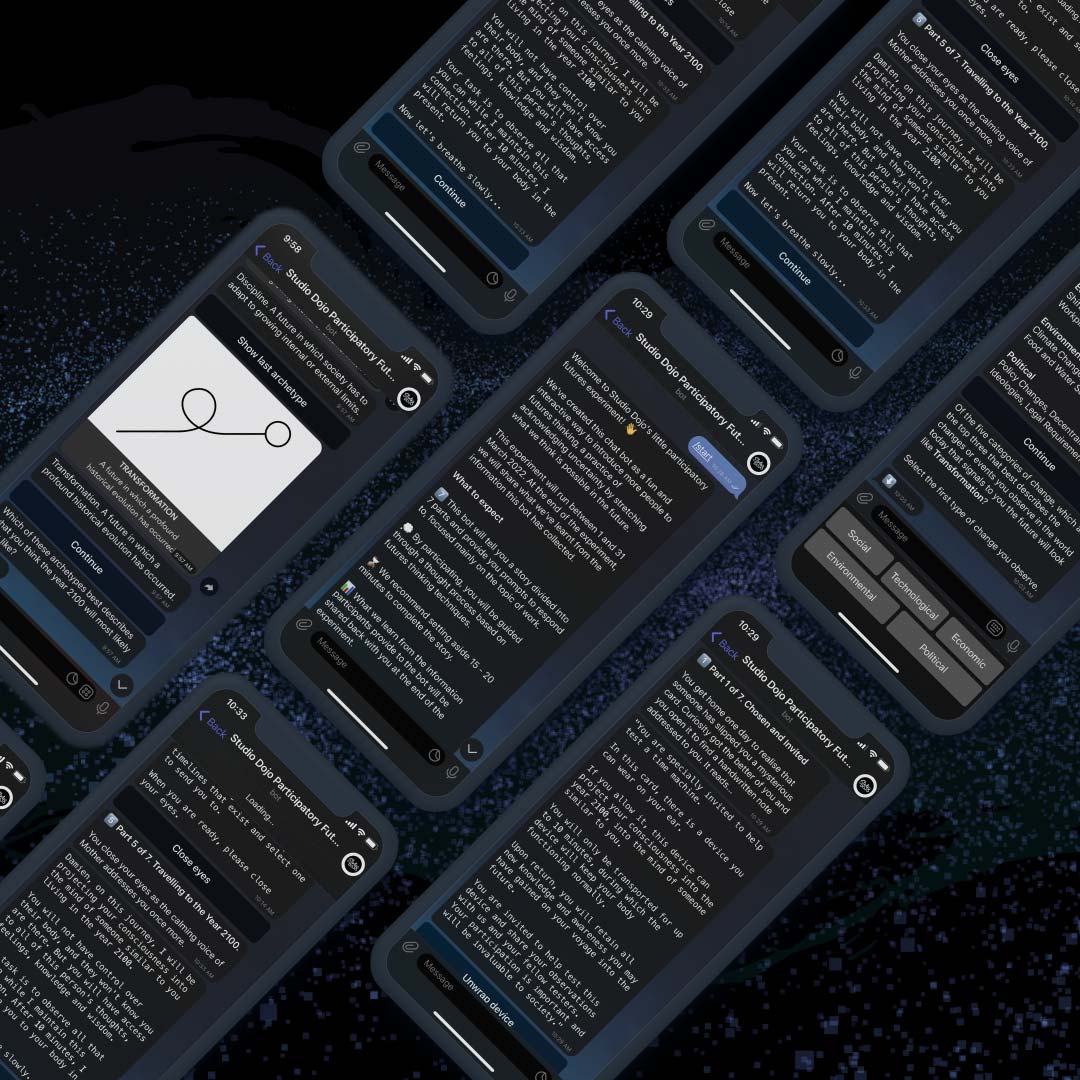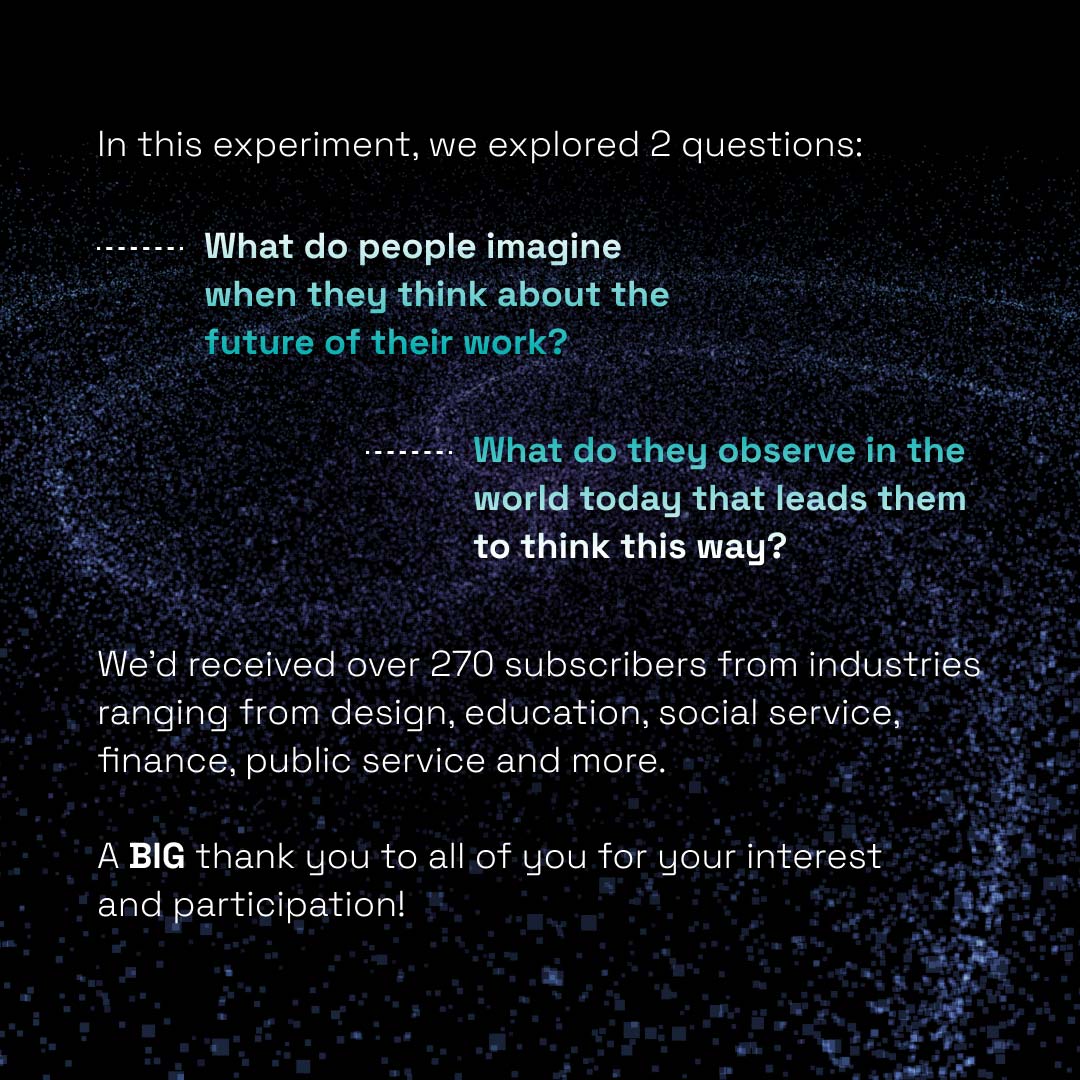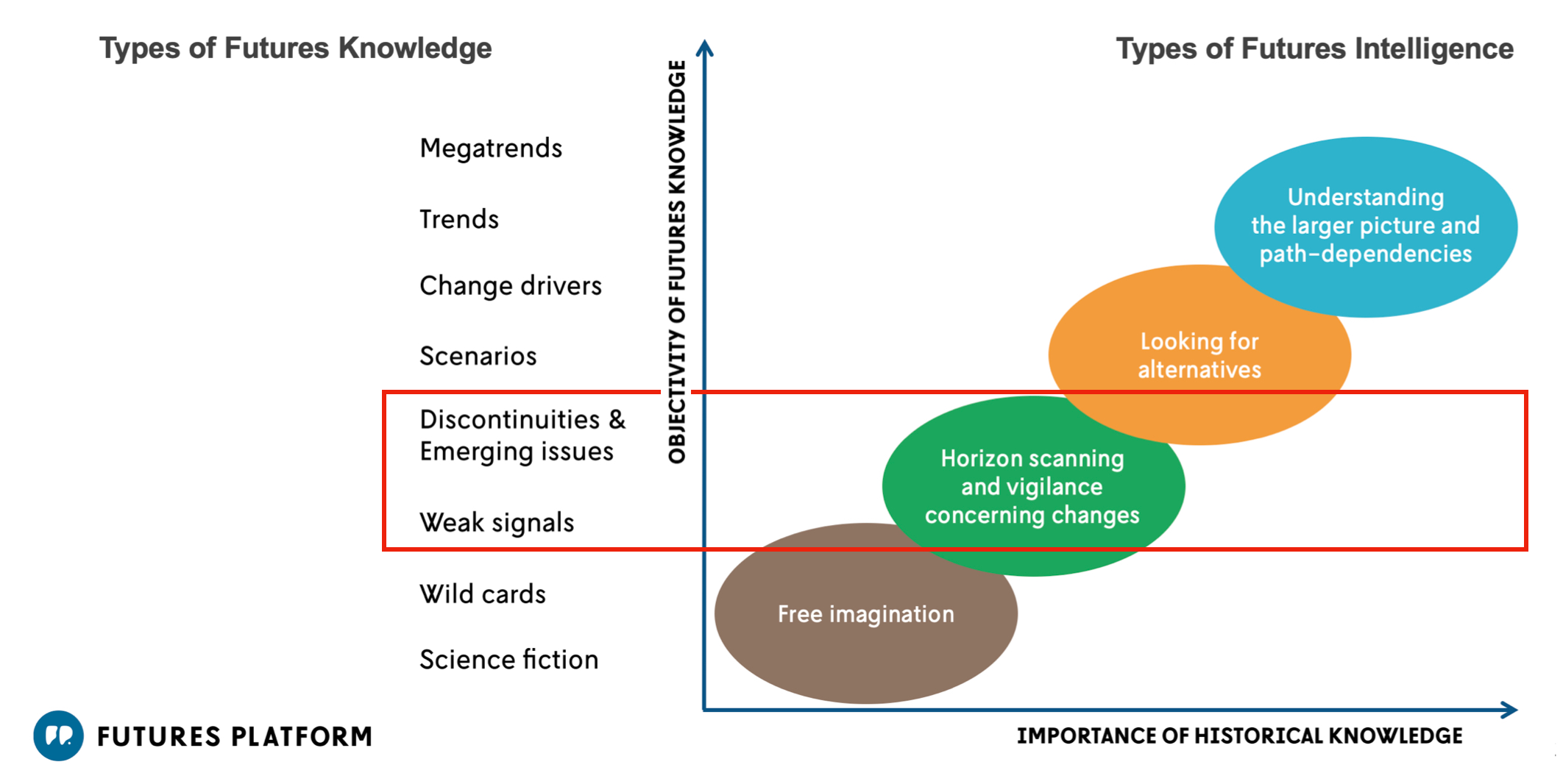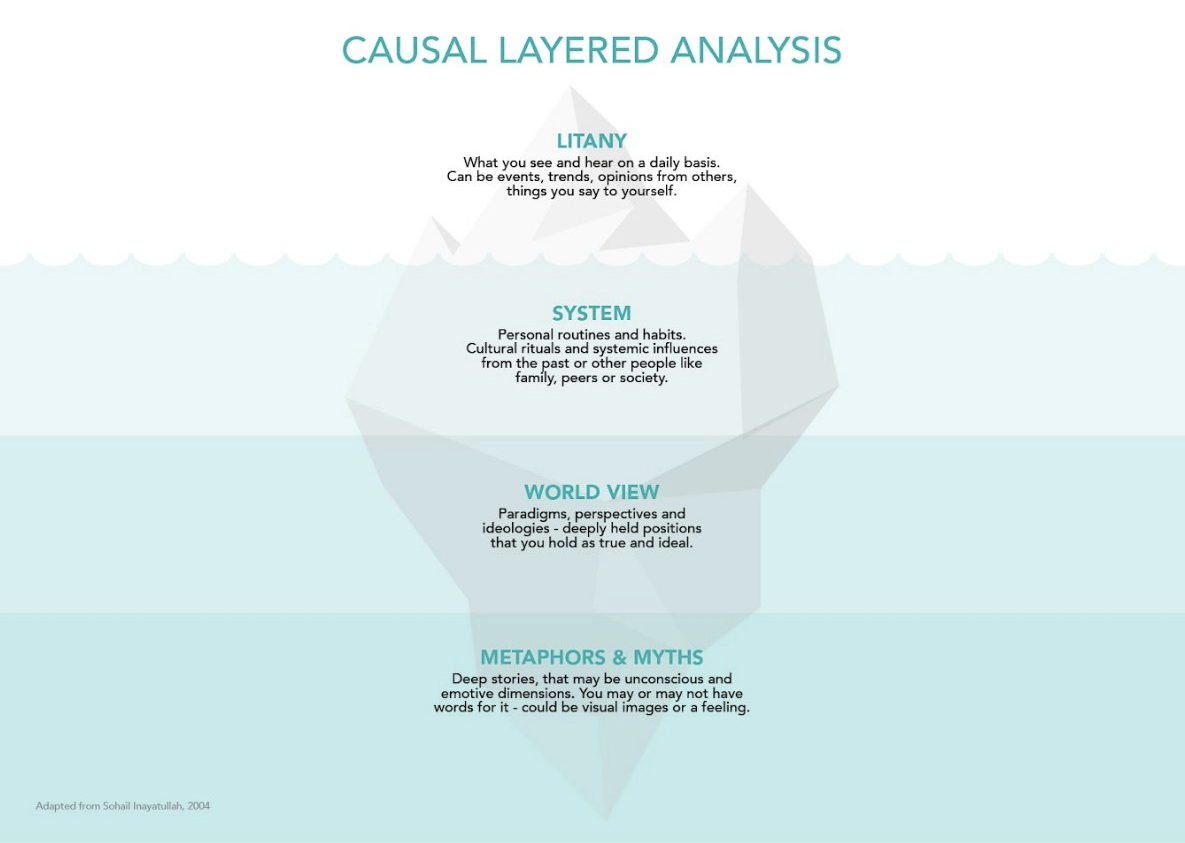What is this experiment
What might we uncover if we could draw a diversity of people to reflect on the long term future of their work, in a fun and structured manner?
This is the question driving Studio Dojo’s exploration in participatory futures, leading us to create a chat bot (https://t.me/sdparticipatoryfutures_bot) on Telegram.
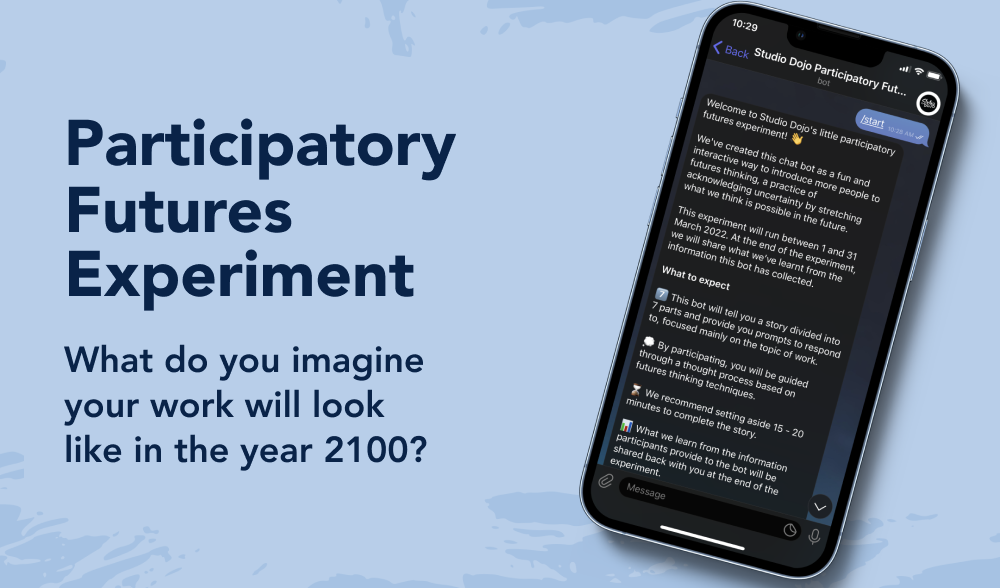
This chat bot ran from 1 to 31 March 2022 and offered a fun and interactive way for anyone to delve into their perceptions of the future of their work and why they think so.
We hope that doing this would help uncover a crowdsourced collection of events or changes that people see in the world today which leads them to think the way they do about the future.
We believe that such a collection, when sorted by relevance to industry or job type, can produce some interesting information for today’s business and community leaders, policy makers, entrepreneurs and more.
Insights & Data Visualisation
Together with Studio Kontinentalist, we have consolidated the responses collected by the bot and are happy to present it here.
We hope this experiment has sparked your interest in futures thinking and inspired you to reimagine your futures!
About the chat bot
We’ve created this chat bot as a fun and interactive way to introduce more people to futures thinking, a practice of acknowledging uncertainty by stretching what we think is possible in the future.
How it works
- This bot tells a story divided into 7 parts and provide the user prompts to respond to, focused mainly on the topic of work.
- Participants will be guided through a thought process based on futures thinking techniques.
- It takes approximately 15 – 20 minutes to complete the story.
The chat bot is now having a rest and taking a break…
Why is Studio Dojo doing this
Introduce more to futures thinking
We believe everyone has the capacity to think about the future. But harvesting our thoughts about the future in a way that is useful and relevant to us today requires some skills, mindsets and tools. These tools have traditionally been confined to expert consultants or the meeting rooms of organisations.
Inspired by the work of the Global Swarm, this experiment is our attempt to introduce more people to some of the practices of futures thinking through more participatory methods. We hope this helps people develop a greater awareness and understanding of future trends and their potential impacts, thus ultimately expanding their abilities to respond to them.
Explore the intersection of design and futures
We see many areas where design and futures thinking overlap, intersect, and build on each other, allowing us more ways to respond to an increasingly complex world. This experiment is part of our continued efforts to explore the areas where these two fields meet.
Futures techniques used in the chat bot
(1) Dator’s Four Futures
Where in the chat bot was this technique used?
These four images used in the chat bot are based on the four futures by Jim Dator, professor and Director of the Hawaii Research Center for Futures Studies.
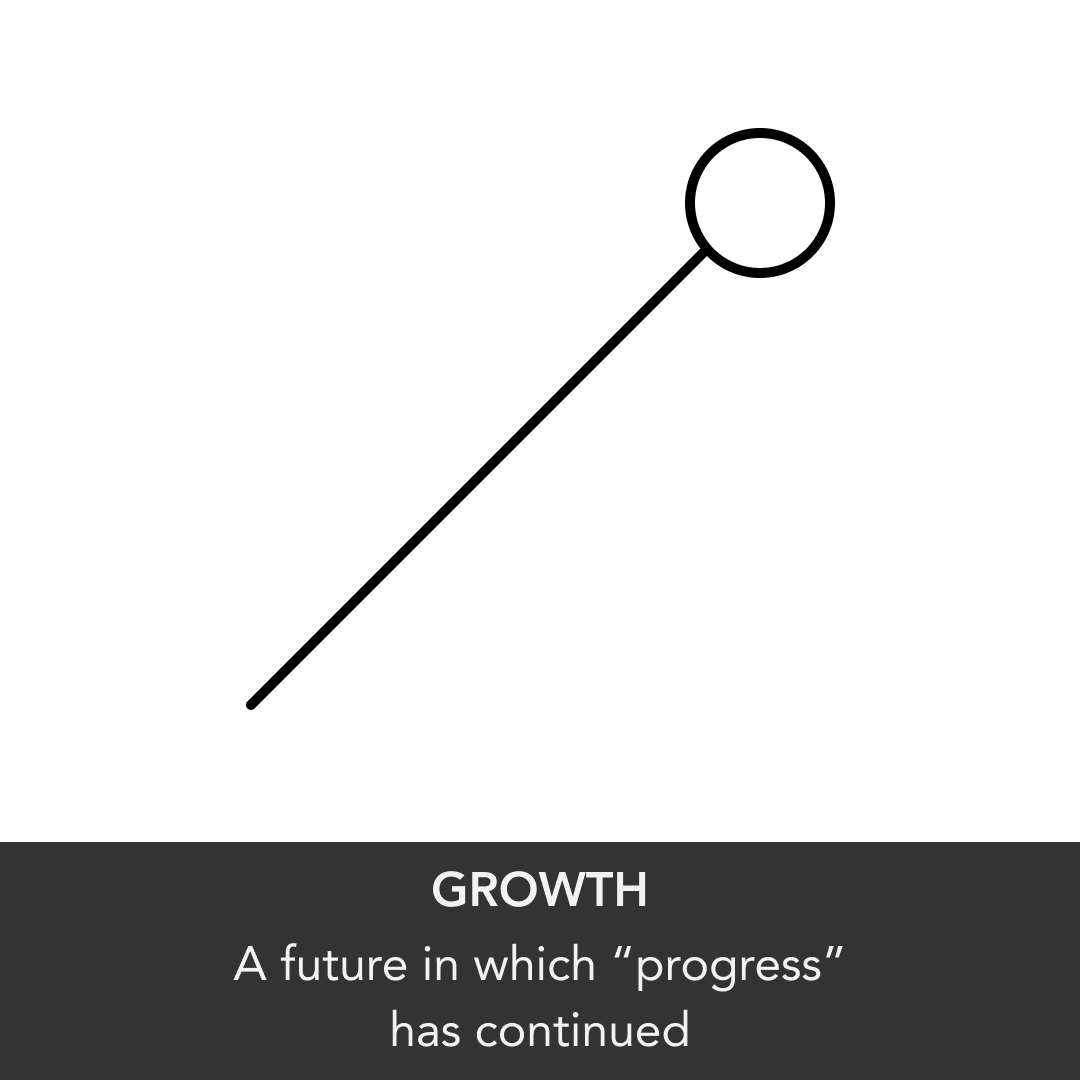
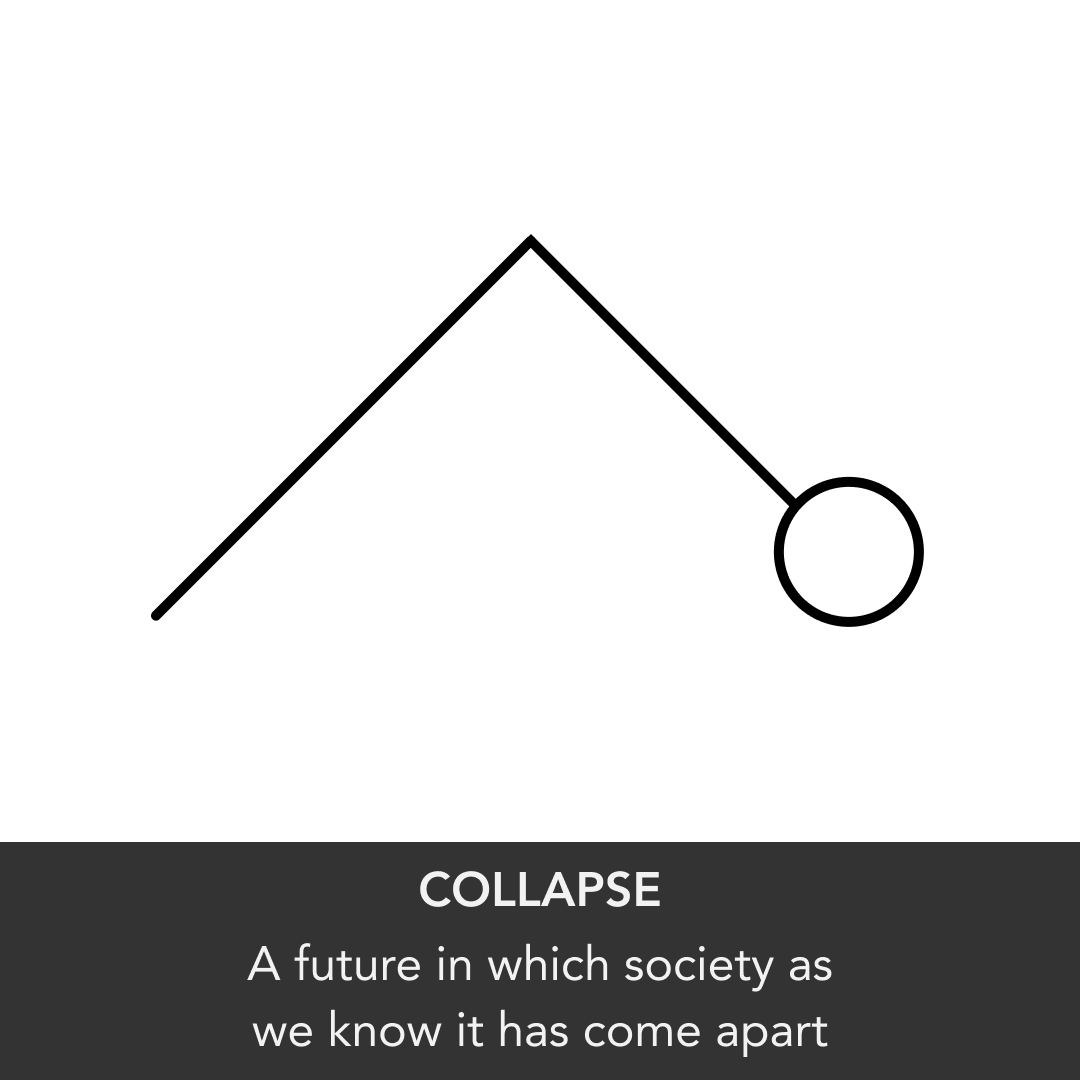
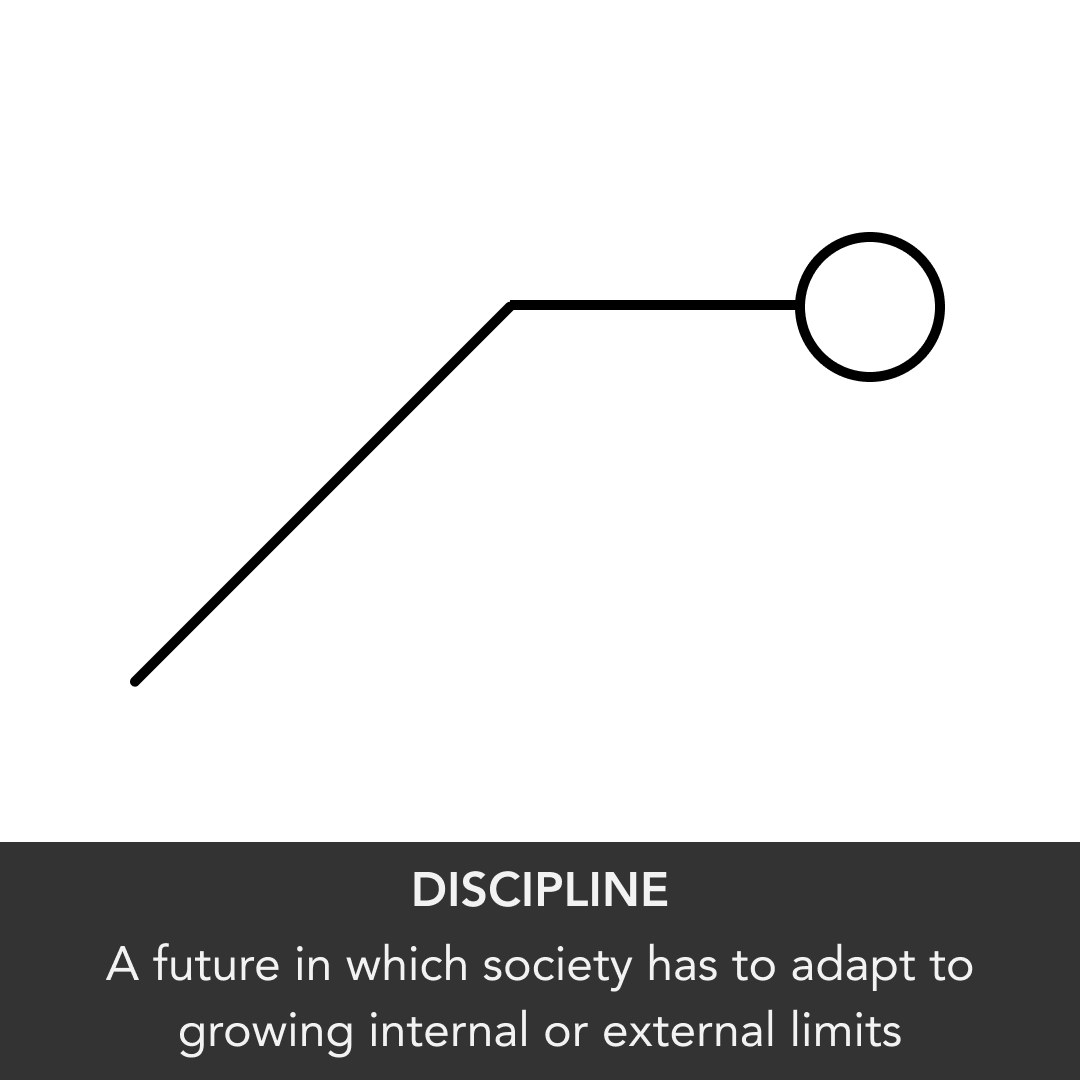
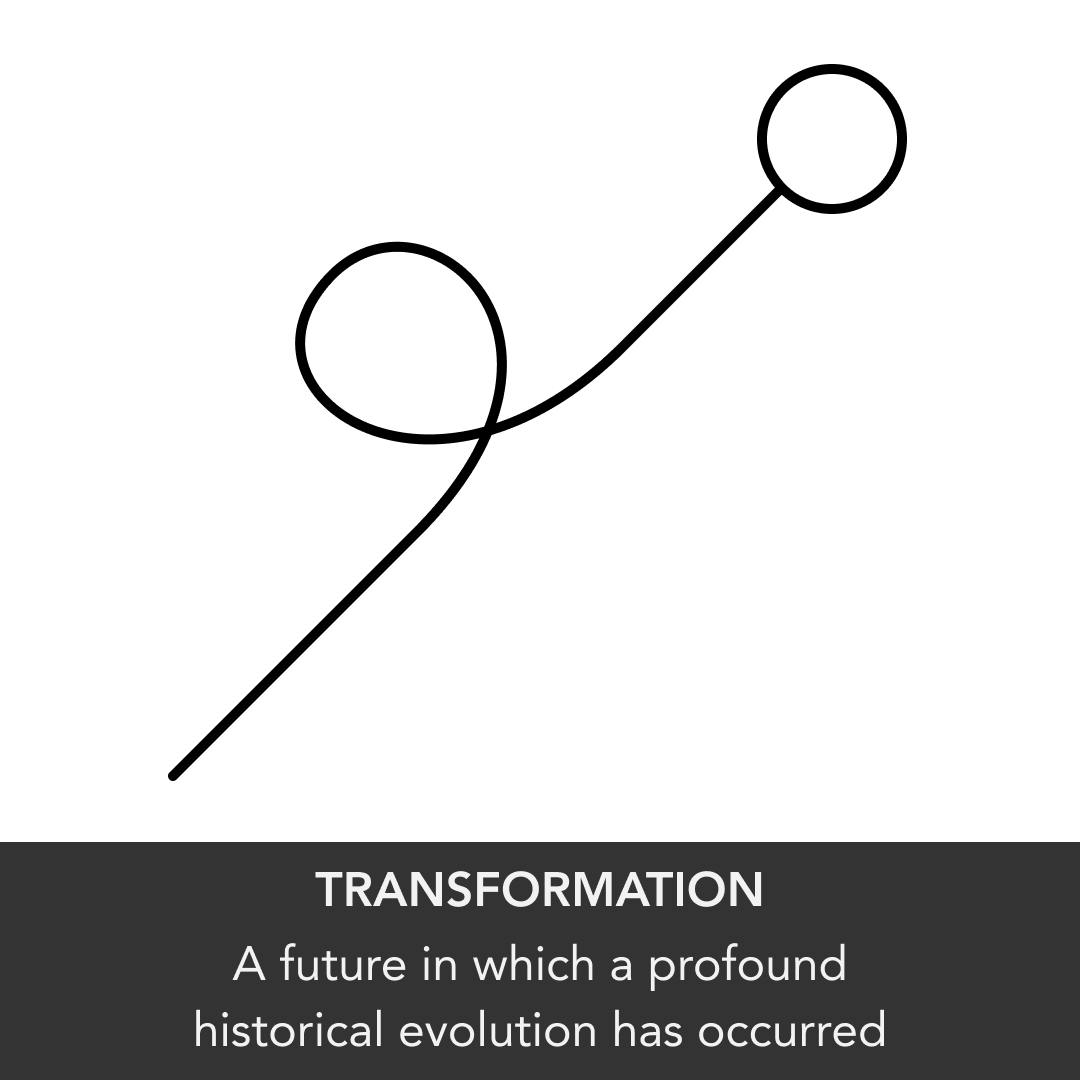
About
Dator’s model observes that all narratives (stories, scenarios) on social change issues can be classified into four recurring groups of images, stories, or policies regarding the impact of that particular change.
- Continuation: business as usual, more of the status quo growth
- Limits and Discipline: behaviours to adapt to growing internal or environmental limits
- Decline and Collapse: system degradation or failure modes as crisis emerges
- Transformation: new technology, business, or social factors that change the game
We attempted to use these same four images as a simple way to ease participants into examining the stories they hold about the future.
Sources:
Alternative Futures at the Manoa School
Jim Dator (2009)
Dator’s Four Futures
Foresight University (2019)
Advancing futures. Westport, Conn.: Praeger.
Dator, J. (2002)
(2) Horizon Scanning
Where in the chat bot was this technique used?
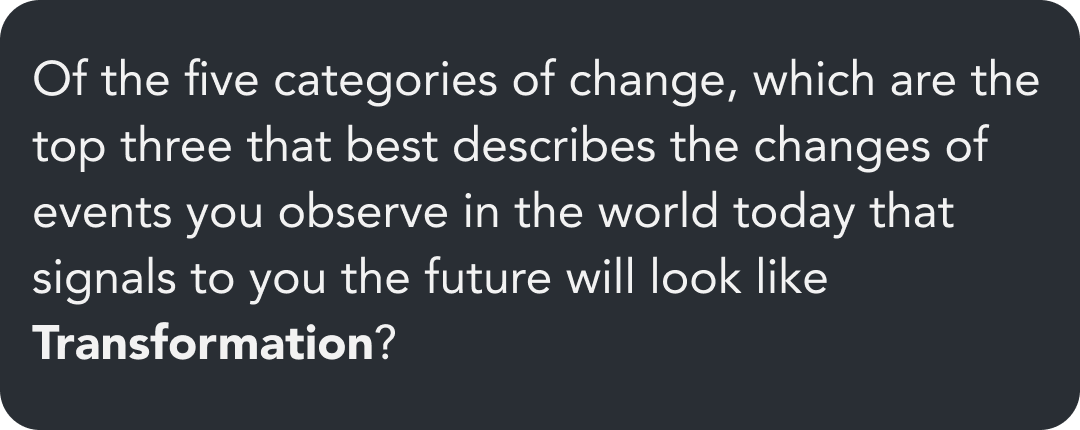
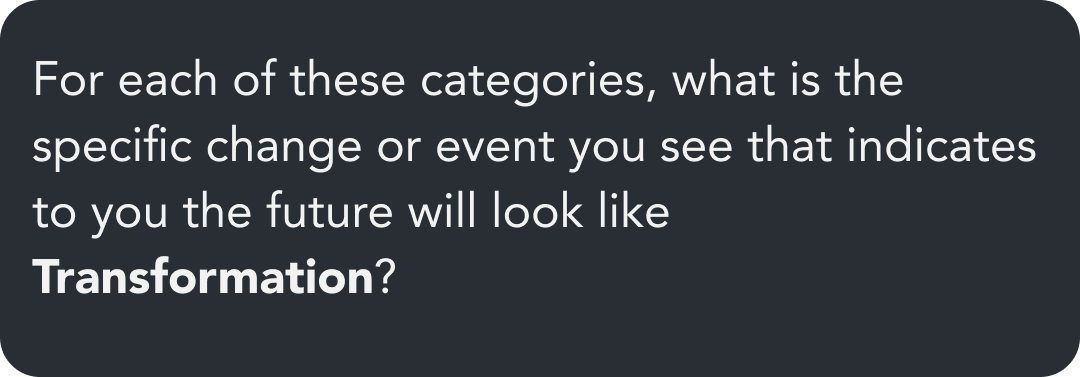
About
Horizon scanning, also known as environmental scanning, is a futures thinking method used for discovering early signs of potential change. The main objective of horizon scanning is to be vigilant concerning changes by identifying discontinuities, emerging issues and other signals of change.
In futures thinking, there are specific definitions for different types of futures knowledge. They are roughly:
Megatrends. Global, long-term change developments that impact business, economy, and cultures on both individual and societal levels. They are combinations of multiple trends, phenomena and issues that are intertwined with each other.
Trend. A trend has a recognisable development path that is supported by multiple credible sources. It is a flow of transformations that is not redirected easily
Change Drivers. Internal or external forces that push a change forward and shape organisations, societies and markets.
Discontinuities. Changes in trends, culminations, breaks, or decisive turning points at which a significant historical event or change occurs.
Emerging issues. Novel things that are just beginning to form, potentially driving change in the working environment.
Weak signals. Early signs of potential discontinuities and emerging issues, such as new technologies that are still in the infant phase.
Typically, horizon scanning is done systematically to identify discontinuities, emerging issues and weak signals, rather than any of the other types of futures knowledge.
In our participatory futures chat bot however, we did not want to use technical definitions to keep the futures thinking process approachable for everyone. Instead, we attempted to elicit whatever futures knowledge participants may have on the top of their minds, be it a megatrend, change driver, weak signal, and so on.
Sources:
(3) Causal Layered Analysis (CLA)
Where in the chat bot was this technique used?
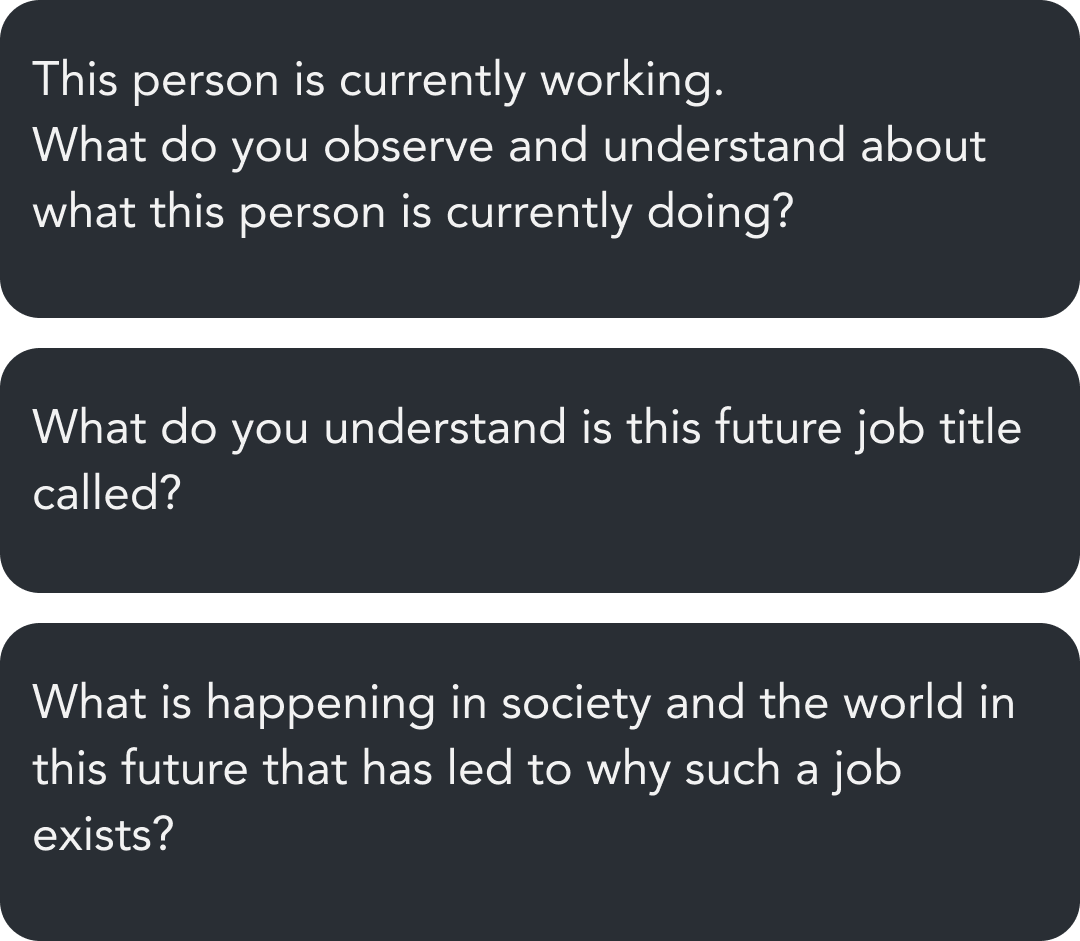

Causal Layered Analysis (CLA) is an approach and a technique used in futures thinking to shape the future more effectively. It was pioneered by Sohail Inayatullah, Professor at Tamkang University.
CLA works by identifying different levels of analysis to create coherent new futures. This technique focuses on depth rather than breadth, helping us to deepen our imagination of possible futures past the surface in four layers.
Litany. The first level is the “litany” – quantitative trends, problems, usually presented by the news media. The litany level is the most visible and obvious.
Systemic Causes. The second level is concerned with social causes, including economic, cultural, political and historical factors (rising birthrates, lack of family planning, etc.). Interpretation is given to quantitative data.
World View. The third deeper level is concerned with structure and the discourse/worldview that supports and legitimates it (population growth and civilizational perspectives of family; lack of women’s power; lack of social security; the population/consumption debate, etc.). The task is to find deeper social, linguistic, cultural structures that are not dependent on who are the actors.
Metaphors & Myths. The fourth layer of analysis is at the level of metaphor or myth. These are the deep stories, the collective archetypes, the unconscious, of often emotive, dimensions of the problem or the paradox (seeing population as non-statistical, as community, or seeing people as creative resources, etc.). This level provides a gut/emotional level experience to the worldview under inquiry.
In the chat bot, we tried to guide participants to imagine the future in three steps, roughly following the layers of the CLA. This was done in an attempt to help participants deepen their imagination of the future, while still keeping it easy to approach.
These prompts in the chat bot correspond to which layer of the CLA we attempted to evoke.
Litany
This person is currently working.
What do you observe and understand about what this person is currently doing?
What do you understand is this future job title called?
Systemic Causes
What is happening in society and the world in this future that has led to why such a job exists?
Metaphors & Myths
What do you think is a metaphor this person would use to describe the world they live in?
Sources:
Causal Layered Analysis. Futures, 30(8), pp.815–829.
Inayatullah, S. (1998)
Causal Layered Analysis, Poststructuralism as Method
Inayatullah, S. (1998)
Further reading
What is Futures Thinking
Provides the mindsets and skillsets to consider further into the future, and to readily simulate and explore multiple possible futures that may happen as a way to stretch creativity and question current assumptions.


